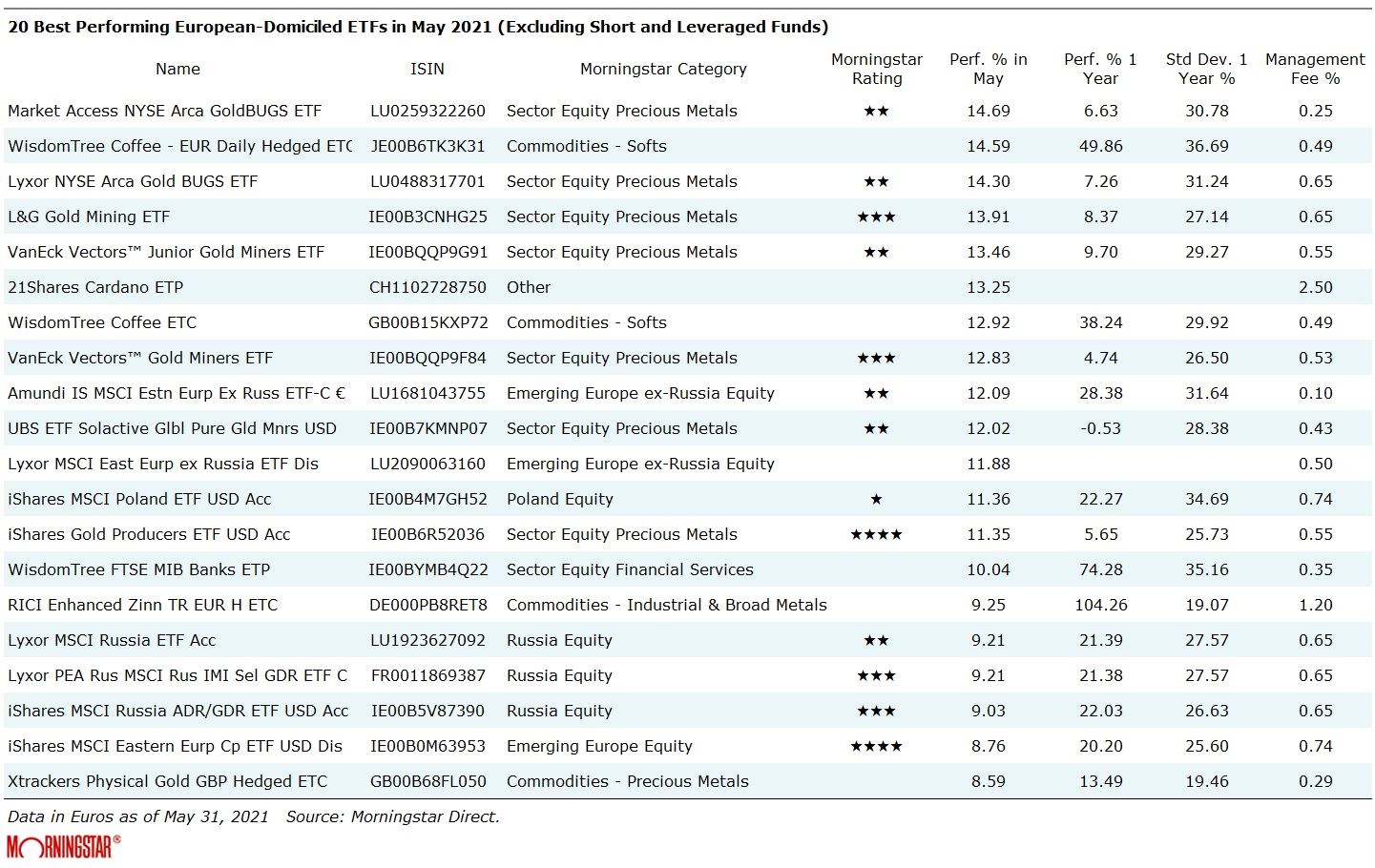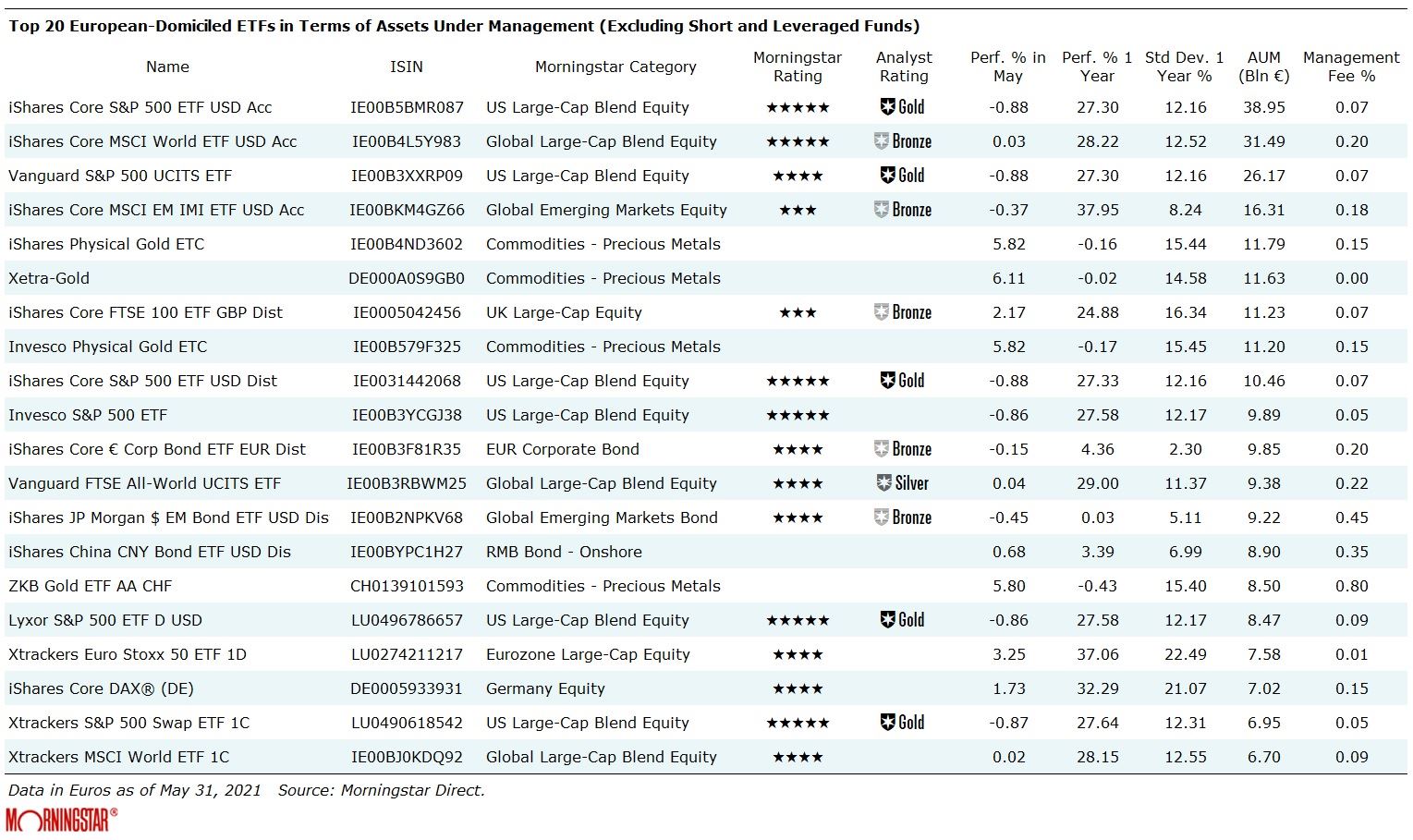
According to Morningstar data, there are about 60 percentage points between the best and worst performing European exchange-traded products (ETPs) in May, with returns for the month ranging from 14.6% to -45%.
We have looked at the key trends in the fifth month of the year, excluding inverse and leveraged funds. These instruments, being purely passive products, reflect the evolution of the markets without the bias (good or bad) of an active manager.
The Leaders
The Top 20 of Exchange traded products (ETPs) is led in May by the Market Access NYSE Arca Gold BUGS Index UCITS ETF (GOLB), which invests in an equally weighted basket containing the major companies active in the extraction of gold; currently, the benchmark counts 51 components.
After a subdued start to the year, the spot price of the yellow metal rose in May from $1,768 to $1,905 an ounce, in the wake of fears about the possible overheating of the global economy. Indeed, the US dollar and inflationary pressures are the two major drivers that will arguably continue to support the gold sector. The United States is contemplating putting trillions of dollars into the market for various programs and that devalues the dollar itself, which is bullish for gold. If the yellow metal were to cross the psychological threshold of $2,000, it could be pushed further.
In second place there is WisdomTree Coffee - EUR Daily Hedged (ECOF). One of the main producing countries, Brazil, is experiencing the worst drought in the last 90 years. That’s why Brazilian coffee farmers are trying to renegotiate their sales contracts with exporters and traders at higher prices. Arabica coffee futures have risen to a four-year high the last week of May, on looming supply tightness and demand recovery post-Covid.

The Laggards
Several cryptocurrencies plunged last month as some negative news has dampened investors’ sentiment on bitcoin and its peers. The bitcoin price dropped from over $60,000 to under $35,000 from mid-April to the middle of May. Ethereum, the second-largest cryptocurrency by value after Bitcoin, lost half its value in just two weeks as its price tanked in the aftermath of the Bitcoin sell-off while its rivals cardano and binance BNB also crashed. The recent slide is a reversal from the dramatic rise that started in the second half of last year.
A serious blow came from China, as Beijing banned banks and payment firms from providing services related to cryptocurrency transactions. On May 18, three state-backed organisations, including the National Internet Finance Association of China, the China Banking Association and the Payment and Clearing Association of China issued a warning on social media stating that consumers would have no protection if they were to incur any losses from cryptocurrency investment transactions.
Needless to say, Elon Musk’s activity on Twitter contributed to trigger the wave of sales (at least, partially). On May 13, Musk announced that Tesla would stop accepting Bitcoin payments for its cars due to environmental concerns regarding Bitcoin mining. Besides, during an exchange of tweets, Tesla’s founder hinted that the electric vehicle maker could sell its positions in Bitcoin, but few days later he clarified that Tesla has not sold.
It is not the first time that Musk, who has been a big supporter of Bitcoin – although he seems to have reversed course in recent weeks in favor of dogecoin – is at the center of the controversy for his communication on Twitter regarding investments in cryptocurrencies.

The Biggest
Monthly top and flop performers often coincide with very volatile and therefore risky products, which should play a satellite role in your portfolio. Below you have an overview of the biggest European-domiciled ETPs in terms of assets, which could be more appropriate to consider among core holdings. Monthly performances go from 6.1% of the Xetra-Gold (4GLD) down to the iShares Core S&P 500 UCITS ETF USD (CSPX), which lost 0.9% in the month.









.jpg)



















